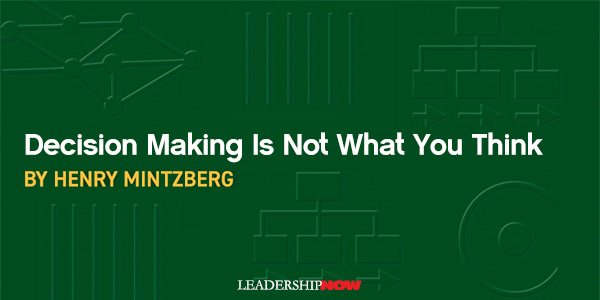 |
 |
03.13.23

Decision Making is Not What You Think
HOW TO find a spouse? We all know how to make important decisions. First we diagnose (figure out what the problem is), next we design (identify possible solutions), then we decide (evaluate each, and choose the best), and finally we do (carry that choice into action). In other words, we think in order to act. I call this thinking first. Finding your spouse was probably the most important decision you made in your life. Did you think first: made a list of what you were looking for — say, brilliant, beautiful, and bashful; or strong, sexy, and steadfast — then list all the possible candidates, analyze their score on each of these criteria, add up all the scores to find out who won, and inform the lucky person? The problem is that your chosen is likely to have replied: “While you were going through this rigamarole, I got married and had two kids.” Thinking first does have its drawbacks. If this is how you proceeded, you’re probably still single (unless you’re Indian — it often works in India, but with the family doing the thinking). So maybe you proceeded differently, like my father, who announced to my grandmother: “Today I met the woman I’m going to marry!” There was not a lot of analysis in this decision, I assure you, but it worked out well. A long and happy marriage ensued. This is known as “love at first sight.” As a model of decision making, I call it seeing first. Even some rather formal decisions happen this way. For example, some might buy a car because they like the looks of it. Others might even buy a company upon first sight. These aren’t necessarily whims; they can be insights. But there’s another, sometimes more sensible way to make decisions. We don’t think in order to do, we do in order to think. Hence, I call it doing first. Not being sure how to proceed in the affairs of love, or what might make a suitable spouse, we meet someone and try living together to find out how that works. If it does, we continue. We may even get married. If not, we try someone else. Start small to learn big. In business, this could apply when thinking of raising your prices. You start with some test market. If that doesn’t work, you re-engineer your product to lower its cost. This too has its drawbacks. As described by Terry Connolly, a professor of decision making, “Nuclear wars and childbearing decisions are poor settings for a strategy of ‘try a little one and see how it goes.’” No doubt! But there are a lot of other decisions for which this proves to be a perfectly acceptable course of action. IKEA came up with its strategy of selling its furniture unassembled after a worker had to take the legs off a table in order to get it in his car. “If we have to do this, what about our customers?” Rest assured that IKEA must have tried this on a few items before it changed to its “assembly required” line of products. These days, there’s a lot more seeing first and doing first than you might think, and not only in the world of romance. Look for it in every business, government, and NGO. For example, to hire a new employee, we can, of course, go through the whole process of diagnosing and designing and deciding. Or we can just interview some likely candidates and pick the first one who just seems right — decision at first sight — trusting our intuition. Or, if we’re not sure, we hire one on contract for a few months to see how they work out. We learn from doing. Of course, just as thinking first can be tricky, so too can seeing first. We might not see past the surface. As for doing first, think about, not only having a baby or starting a nuclear war, but also wherever other small engagement can result in an irreversible commitment from employing this tactic. Think, See, Do. All are necessary in the world of decision making. Sometimes one, sometimes another, sometimes together, but not necessarily in that same order.  
Posted by Michael McKinney at 07:14 AM
|
BUILD YOUR KNOWLEDGE


How to Do Your Start-Up Right STRAIGHT TALK FOR START-UPS 
Grow Your Leadership Skills NEW AND UPCOMING LEADERSHIP BOOKS 
Leadership Minute BITE-SIZE CONCEPTS YOU CAN CHEW ON 
Classic Leadership Books BOOKS TO READ BEFORE YOU LEAD |